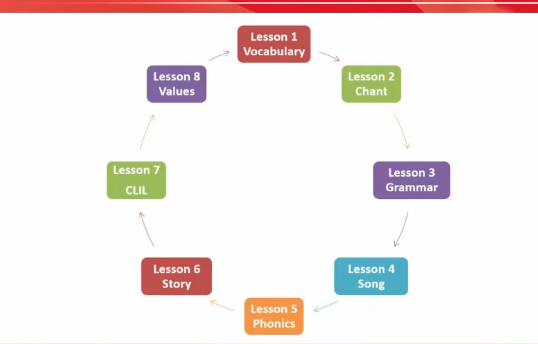一般疑问句学习Are those....?
Yes, they are. / No, they aren't.
一般疑问句学习Are those....?
Yes, they are. / No, they aren't.
I hear and I forget.
I see and I remenber.
I do and I understand.
第一章课程介绍
1overview
教学理念
1Context:
第一单元:零基础导入,以家庭为故事主线
每一单元:主题式情景化教学,双重故事情景(K1-2家和玩具)
2Multi-intelligences多元智能
不同的活动锻炼:观察智能 逻辑智能
3CLIL教学法: Content and Language Integrated Learning 英语与学科完美同步
Using English to Learn
Learning to use English
Aims:Context Communication Cognition Culture最重要的四个点
低年级在听力中学习知识(泛听
高年级在阅读中学习知识(泛读
4 Bring Values into the classroom
低年级在故事中培养积极价值观
高年级在阅读中发现积极价值观
5 Evaluation
关注孩子能做的what they can do, rather what they can't do,培养孩子自信心和学习英语的愿望
Portfolio--教材附带测试题,学生自测
让孩子在轻松和自我检测中学习英语
教学大纲syllabus
1 Content Recycling内容复现
每个阶段 每一册 每一单元 每一课 它们之间 如何实现内容复现
KB1-2 Unit Structure
EX: BOOK1 Unit6 My face
Lesson1 P40 Vocabulary 通过情景学习词汇
Vocabulary focus:key unit language is introduced on the first unit page.
Lesson2 P41 Chant
Vocabulary is practised on the second page.页脚有单词清晰指示
Lesson3 P43 Grammar/key structure
Grammar focus: new grammar is introduced on the third page.
页脚清晰指出语法点
L4 P44 Song 巩固复现语法
Grammar is pratised on the fourth page.
L5 P45 Phonics语音学习
New phonics sections and communicative games are included on the fifth page.
(活动9)Phonics activities reinforce the link between reading, spelling and pronounciation.
(活动10)Communicative activity revises key language and practises speaking. output
L6 Story 故事教学-复现语言知识点P45 this page is dedicated to reading for pleasure. The fun story running throughout each level reinforces unit grammar and vocabulary.
L7 CLIL P46 两个单元就会加入一个CLIL教学
New CLIL sections feature at the end of every two units. They build on children's knowledge of other subjects through English.
L8 Vaules 同样每两个单元有一个vaules section. New values pages fulfill key curriculum requirements at this level and help develop student's social awareness.

每四个单元有一个Review Unit
一二册以听说为主,读写引入
三四册听说读写全面发展
KB 3-4 Unit Structure
EX: KB3 Unit3 A day in the life
P1-4 词汇&语法 体现+进阶
第一页 input
Activity1 Vocabulary by listening
A2-3 Voca&Grammar
第二页 词汇 语法巩固 intake
listen and speaking 练习
第三页 通过listening and speaking学习语法
+与写作结合进行输出(input intake内化)
第四页 A11A12 reading&listening --grammar A13speaking&writing--grammar 听说读写练语法 intake output
P5语音教学listening and speaking (Output
P6 故事阅读 Lock+key侦探故事(新语境
P7-8 CLIL教学-泛读学习
5-6册没采用
(二级课程是小学毕业要求,KB二级就基本全覆盖,季节与天气在KB3)
2 Skills Progression
skills progression 技能进阶
listening
speaking
reading
writing
语音语调变化,清晰发音
Are you ready?
1 Warming up
放音频动画,教师跳舞,学生模仿
2 Guessing
①有四个不同箱子的火车,学生猜里面装了什么动物
②放音频:不同动物的录音
再次问学生答案,一个个揭示答案
③zoo简图,让孩子找到刚刚的动物应该在动物的哪里,如鳄鱼——池塘
3 参观动物园
动物园开业啦,谁会去参观动物园(看图说人
图画+动作,引出monkey,展示图片
对身体部位提问。PPT+手中单词卡片
arm hand leg(学生不会读就教读)tail foot
Q: what have they got?(can you read it together aloud?)
录音--提问--回答--确认(二组加一分(分组得分
Disscusion: talk with parters "what have they got
long tail, big nose,...
Can you say it together, let it go.
录音--提问--回答
next animal
elephant, group discussion,教师走动查看
游戏spin the spinner 转盘
snakes monkeys crocodile elephants
学生一起问 what have they got?
一个学生形容 they've got ..
不能 看屏幕的人猜是什么
教师演示第一遍,带着学生做第二遍,然后道具发给每个组进行游戏
每个组查看情况,并维持纪律,到时间回收道具
复习:today we have learned four kinds of animals, they are,
Q: which animla do you like? what have they got? why do you like it?
提问-小组加分
动画-crazy zoo--crazy ideas about animals"snigers"
美术课画过,写下它们的特点
How can we write?
Name-Colour-Size-Body parts-Ability
I have some words that may help you.给出提示词(各个方面会用的词+固定的句型部分
请同学分享
结束语:did a great job,take your pencils...整理东西
Warm-up
1Greeting
2rainbow歌曲
动画+教师带着唱歌+动作
Aim:活跃气氛+熟悉颜色词汇
3 不同的卡通图片,请学生说出 什么颜色+物品名称
(这个环节,每当学生回答后教师都重复一遍,这种行为是不可取的,或者必须慎用的)
教师可以总结,不需要强调,宁可让学生一起读,或者让其他同学重复(关注课堂 关注同伴,而不是都集中在教师身上
除非是很重要的知识点,学生听不到
Presentation
Q&A:教师没有解释funfair(游乐场)的含义,但是教师需要确认学生理解该词含义之后再往下进行其他教学环节。
教学环节:放游乐场的动画
Q:who can you see?
A: 学生回答看到的人物
Activity:看对话动画again
listen and repeat 听录音,学生跟读
单个单词重复读,卡片辅助
贴纸奖励激励学生课堂表现
【比起教师自己做示范,我们更应该选择播放教材录音,来给学生展示单词的正确发音】
role-play读对话
Practice
(低年级学生 give me five)
让学生反复练读对话,中的不同部分,注意
颜色词+乘具+乘具对应介词
教学活动:
A1提问+图片:让学生读where is +she is on the XX ,单独回答+齐读,(道具)单独学生贴道具+单读
A2听录音,(黑板给出原文)一句一句齐读
A3Game:给出9个黑白乘具图片和许多颜色,(录音放red lorry) 带着全体学生做两个练习(找到乘具。说出颜色);然后让学生上前单独选择
{评语“everyone did a great job.”学生形成条件反射,立刻鼓掌了}
A4两个学生上前,word card and 乘具pictures,老师读“XX is in helicopter”,学生快速找到helicopter的单词卡和图片。(示范)
然后每组学生都有卡片,整体做这个游戏,给反应最快 的学生贴纸。3-4次
A5看黑板上的人物、乘具贴图,提问“who is in the helicopter”,贴图第一套老师留下,其他让学生带回小组。老师示范“what's this"(对人物提问)"what's this"(对乘具提问)"XX is in the XXX",小组内练习。然后选一组展示(一组学生展示图片,其他学生举手回答,用学的句型(展示在黑板上
教师提问,学生一起回答
【这个活动学生参与度不高,1难度过高2指令不明确3教师没有示范】
Production
新句型“I'm ...”"I'm in/on the ..."
总结,who colour
A:让学生问听课老师问题
Homework
go to the funfair with parents and enjoy
说课《剑桥少儿英语》《多维阅读》
任务型教学方式,让孩子在开放的环境中学习
where is+ she/he is in/on
教学目标
知识目标、能力目标、情感目标
教学重点
TBLT TPR 试听法
歌曲导入
复习 记忆检索
观看视频 整体认识
听录音 跟读 模仿 语音语调
共同完成板书 培养学生综合运用能力
两个同学示范 e'g
小组合作
拓展环节:学生创新 结合实际运用
How to teach VALUES through stories
1what values:
loving nature\politeness\working in teams\making friends\helping others\giving and sharing\
"Children learn best by example and are most receptive when what is shared is experienced"
指令配合:
Greeting
T:端起手臂 S:学生做好
T:one two three S: sit down please
T: class begins S: stand up
T: good morning, boys and girls
S: good morning, amanda
T: nice to see you again
S: nice to see you too
某学生回答正确:全体S竖起两个大拇指:good good good, I give it to you.
跟读:T:follow me S: follow you
回答问题:S:举手,I can try
T: ready? S: go
课前复习:不同颜色的乘具提问(带着学生都知道的动作)
拍桌子打节奏 说句子
"what's he doing" 超人 蝙蝠侠 蜘蛛侠,动作词的进行时
【superheroes导入,1激发学生兴趣2聚焦主题3课堂与学生生活实际联系起来】
"what can you see?"
带领学生猜测一下图片,然后放录音前给出两个问题 。让学生听录音后回答。然后分图片-提问-提示-解释-放录音确认-请学生回答-贴图在黑板上-带着集齐读
【学生分组积分】
【遇到学生难以理解的表达,比如pick up,教师将短语置于完整的句子中,运用动作(TPR)及语调帮助学生理解意义】
superhero的标签:用标签标志hero
所有图片学完,男女生分别起立,双手叉腰,分组分角色齐读(女to男,wow you are my superhero)
提出问题,watch the story again,这次带动画
主题式情景化教学
star family为主线
会存在双重故事情境KB1-2级:STAR一家和玩具
多元智能(通过观察匹配图片,学习语言)
逻辑智能(lion,lion,tiger...)KB3
aims:subject,language,congnition,culture
低年级:泛听学习知识
高年级:泛读学习知识,培养价值观
1&2 一级
3&4 二级
5&6 三级(剑少考试)
KB3-4:learn vocabulary through learning
learn vocabulary and grammary through reading
learn grammar through listening and speaking,
output:through listening ,speaking and writing
I hear and I forget. I see and I remember. I do and I understand.
What's CLIL?
Content and Language Integrated Learning (CLIL)
Using English to Learn
Learning to use English
Match the aims with the descriptions.
Aims:
Subject: Develop thinking skills from the start.
Language; Learn to use English (Academic English)
Cognition
Culture:
Use English to learn (Academic knowledge)
Learners with different home languages as well as different social and cultural backgrounds sometimes need to communicate in a non-native language.
Evaluation
We focous on what children can do, rather than what they can't do.
营造一个轻松,有效的环境来学习。